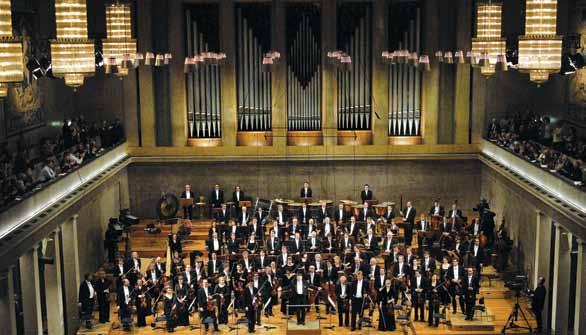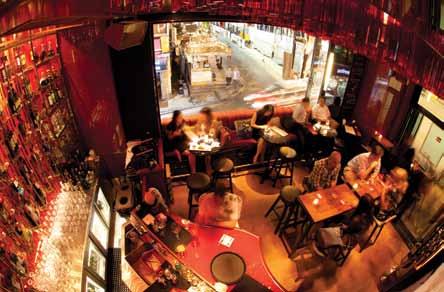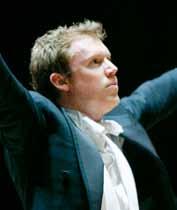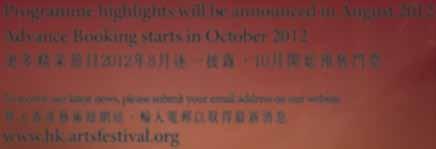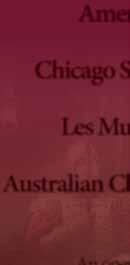巴伐利亞電台交響樂團
Bavarian Radio Symphony Orchestra
(Symphonieorchester des Bayerischen Rundfunks)
巴伐利亞電台交響樂團於1949年由德 國指揮家尤金‧約甘創立不久後,便
躋身成為國際級樂團,演出頻繁、聲
名大噪。巴伐利亞電台交響樂團曾由
多位傑出指揮帶領,其樂手能演奏各
種類型的音樂,技術超凡,樂團的曲
目非常豐富,音樂風格廣闊。
推動新音樂是巴伐利亞電台交響樂團
的悠久傳統,樂團一直以參與由卡 爾‧赫特曼於1945年創立的「音樂萬 歲系列」為重點活動之一。在這些音 樂會中,慕尼黑的聽眾見證了當代作 曲家站在樂團當中,指揮自己作品的 歷史場面。這些作曲家包括史達拉汶
斯基、米堯、欣德米特、布萊茲,還 有最近的如施托克豪森、卡傑爾、貝 里奧和烏特夫斯。
巴伐利亞電台交響樂團曾與無數傑出 指揮合作,包括卡魯斯、卡拉伯父
子、夢殊、法列薩伊、克倫白勒、布
Soon after being founded by Eugen Jochum in 1949, the Symphonieorchester des Bayerischen Rundfunks (Bavarian Radio Symphony Orchestra, BRSO) developed into an internationally renowned orchestra, and its fame expanded and strengthened through intensive touring. The orchestra owes its extraordinarily wide repertoire and sound spectrum to the programme preferences of its previous chief conductors as well as to the great flexibility and solid stylistic security of each individual musician.
Fostering new music has an especially long tradition at the BRSO. Its appearances in conjunction with the Musica Viva series, founded in 1945 by Karl Amadeus Hartmann, were one of the orchestra’s main assignments from the start. At these concerts, Munich audiences witnessed legendary performances of contemporary works at which the composers generally stood on the podium of the orchestra. These included Igor Stravinsky, Darius Milhaud, Paul Hindemith, Pierre Boulez, and more
恩、雲狄、蘇提爵士、茲奧連尼、 珊特齡、沙瓦利殊等;而海廷克、慕 迪、沙朗倫和威爾瑟莫斯特皆與樂團 於慕尼黑定期演出。巴伐利亞電台交 響樂團也是伯恩斯坦多年來唯一定期 合作演出的德國交響樂團,兩者關係 緊密,他們的演出為慕尼黑的聽眾帶 來一場又一場精彩的音樂會,如1981 年獻上的華格納《崔斯坦與依索爾 德》便一直教人津津樂道。1989年, 伯恩斯坦與巴伐利亞電台交響樂團及 合唱團演出貝多芬第九交響曲時,把 舒勒《快樂頌》的歌詞由「快樂」改 為「自由」,以紀念東西德之間柏林 圍牆倒下的歷史性一刻。
巴伐利亞電台交響樂團除了在慕尼黑 和其他鄰近城巿演出和作錄音廣播 外,還經常進行巡迴演出,足跡遍佈 歐洲各國、亞洲和南北美洲。樂團是 紐約卡內基音樂廳和日本主要音樂廳 的常客。自2004年起,樂團在現任首 席指揮楊遜斯的帶領下,成為瑞士琉 森復活節音樂節的常駐樂團。
巴伐利亞電台交響樂團亦以推動年輕 音樂家為己任。樂團在慕尼黑聯合 廣播公司國際音樂大賽中,於決賽及 閉幕音樂會中為年輕樂手及得獎者伴 奏。自 2001 年 10 月起,巴伐利亞電 台交響樂團學院更為年輕音樂家提供 教育服務,協助他們發展音樂事業, 為教育與專業發展建立橋樑。除此之 外,樂團亦設有針對青年的發展計 劃,當中有各式各樣的活動,增加他 們對古典音樂的興趣。
recently, Karlheinz Stockhausen, Mauricio Kagel, Luciano Berio and Peter Eötvös. Many renowned guest conductors, such as Clemens Krauss, Erich and Carlos Kleiber, Charles Munch, Ferenc Fricsay, Otto Klemperer, Karl Böhm, Günter Wand, Sir Georg Solti, Carlo Maria Giulini, Kurt Sanderling and Wolfgang Sawallisch have left indelible imprints on the BRSO in the past. Today the likes of Bernard Haitink, Riccardo Muti, Esa-Pekka Salonen and Franz Welser-Möst mount the podium in Munich. For many years, the BRSO was the only German orchestra which Leonard Bernstein regularly collaborated with, which resulted in incomparable concerts, such as the legendary performance of Wagner’s Tristan und Isolde in 1981. In 1989 Bernstein, the Choir and the BRSO altered the text of Schiller’s Ode to Joy from Freude (joy) to Freiheit (freedom) when they performed Beethoven’s Ninth Symphony to mark the fall of the Berlin Wall.
Besides performing and recording in Munich and other nearby cities, the BRSO tours extensively, playing in virtually every European country, Asia and, North and South America. It makes regular appearances in New York’s Carnegie Hall and in the concert halls in Japan’s musical capitals. Since 2004, under the direction of its current Chief Conductor, Mariss Jansons, it has become the orchestra in residence at the Easter Festival in Lucerne.
It encourages up-and-coming young musicians and in conjunction with the ARD International Music Competition, accompanies young musicians in the final rounds and the symphonic closing concert which features the prize winners. Since
Daniel Harding
指揮 Conductor
生於牛津的哈汀起初是拉圖爵士在伯 明翰交響樂團的助手。 1994 年他首
次執棒,指揮伯明翰交響樂團。哈汀 接着於柏林愛樂樂團擔任阿巴度的助 手,並於1996年柏林音樂節中,首次 指揮柏林愛樂樂團。
哈汀現時為倫敦交響樂團 的首席客席指揮、瑞典廣 播交響樂團的音樂總監 和新日本愛樂樂團的音 樂伙伴。他最近獲馬勒 室樂團封為終身桂冠指 揮。他曾擔任馬勒室樂 團的首席指揮及音樂總監
2003-2011)、挪威特 隆赫姆交響樂團的首席指 揮(1997-2000)、瑞典 諾科平交響樂團首席客席指揮(19972003)和布萊梅德意志室內愛樂樂團 的音樂總監(1997 -2003 )。他也是 日本輕井澤大賀會堂的藝術總監。
哈汀是不少樂團的常客,包括德累斯 頓國家樂團、維也納愛樂樂團(他
曾在薩爾斯堡藝術節指揮過這兩個樂 團)、皇家阿姆斯特丹音樂廳樂團、 巴伐利亞電台交響樂團、萊比錫布 業大廳樂團和意大利斯卡愛樂樂團。
此外,他又曾於多個樂團擔任客席指 揮,包括柏林愛樂樂團、慕尼黑愛樂
Born in Oxford, Harding began his career assisting Sir Simon Rattle at the City of Birmingham Symphony Orchestra, with which he made his professional debut in 1994. He went on to assist Claudio Abbado at the Berlin Philharmonic and made his debut with the orchestra at the 1996 Berlin Festival.
He is the Principal Guest Conductor of the London Symphony Orchestra, Music Director of the Swedish Radio Symphony Orchestra, and Music Partner of the New Japan Philharmonic. He was recently honoured with the lifetime title of Conductor Laureate of the Mahler Chamber Orchestra. His previous positions include Principal Conductor and Music Director of the Mahler Chamber Orchestra Principal Conductor of the Trondheim Symphony in Norway (19972000), Principal Guest Conductor of Sweden's Norrköping Symphony (19972003) and Music Director of the Deutsche Kammerphilharmonie Bremen (1997-2003). He is Artistic Director of the Ohga Hall in Karuizawa, Japan. 丹尼奧‧哈汀
© K . MIURA
安東‧巴樂夫斯基
Anton Barakhovsky
小提琴 Violin
巴樂夫斯基生於俄羅斯西伯利亞諾沃
西比爾斯克城,五歲起跟隨里伯曼學
習小提琴,一年後即與諾沃西比爾斯
克愛樂樂團在卡策指揮下以獨奏家身
份於俄羅斯國家電視台演出。巴樂夫
斯基隨後於德國漢諾威音樂及戲劇學
院師隨魯勃斯基和巴列
夏,及後到紐約茱莉亞
音樂學院隨已故演奏家
狄蕾學習。
巴樂夫斯基於 1997 年
在紐約贏得國際青年音
樂藝術家比賽冠軍,這
個獎項讓他能在92街文
化中心進行紐約首演;
隨後他亦於甘迺迪中心
進行首次華盛頓演出,
以及於林肯中心艾莉絲‧塔利廳與紐 約室內樂團首次於紐約演奏協奏曲。
2001年,他獲邀擔任漢堡國立愛樂樂
團的首席小提琴手,同時亦經常以獨 奏家身份與樂團合作。 2009 年 10 月
起,巴樂夫斯基擔任巴伐利亞電台交 響樂團的首席小提琴手。他亦曾帶領 倫敦交響樂團和科隆西德廣播交響樂 團。
他常以獨奏家身份與世界各地的樂團 合作,包括聖彼得堡愛樂樂團、俄
羅斯國立交響樂團、北德廣播交響樂
Born in the city of Novosibirsk in Siberia, Russia, Barakhovsky began studying the violin with Matvej Lieberman at the age of five. Just one year later he appeared on National Russian Television as the soloist with the Novosibirsk Philharmonic under the baton of Arnold Katz. Barakhovsky continued his studies in Hamburg, Germany, working with Mark Lubotsky and Kolja Blacher at the Hochschule fur Musik and Theater. He also studied in New York at the Juilliard School, under the tutelage of the late Dorothy DeLay.
In 1997 Barakhovsky was awarded the first prize at the Young Concert Artists International Auditions in New York that led to his New York recital debut at the 92nd Street Y, his Washington DC debut at the Kennedy Center as well his New York concerto debut with the New York Chamber Symphony at Lincoln Center's Alice Tully Hall.
In 2001 he was invited to join the Hamburg State Philharmonic Orchestra as their first concertmaster, regularly appearing with the orchestra as a soloist. In October 2009 he became the first concertmaster of Bavarian
團、魏瑪交響樂團、漢堡交響樂團、 拉脫維亞交響樂團、漢堡愛樂樂團及 首爾的韓國廣播交響樂團。
他曾於世界各地演出,包括倫敦威格 摩爾音樂廳、紐約卡內基音樂廳和林 肯中心、華盛頓甘迺迪中心、羅馬聖 彼得大教堂(為教宗約翰保祿二世 獻奏)、東京歌劇城,還有柏林、慕 尼黑、漢諾瓦、漢堡、德累斯頓、布 拉格、米蘭、日內瓦、墨西哥城、北 京等地。他亦曾在多個俄羅斯城巿演 出,包括莫斯科音樂學院大廳和聖彼 得堡愛樂樂團大廳。巴樂夫斯基同時 亦是室樂樂手,合作過的音樂家包括 李安‧弗萊舍、馬力吉歐‧普連尼、 莎賓‧美亞、高利亞‧巴列夏、沃爾 夫勒姆‧克瑞斯特和納塔莉亞‧顧德 曼。
他是多個國內及國際比賽的得獎者, 包括莫斯科柴可夫斯基大賽、漢諾瓦 的約阿希姆國際小提琴大賽、全俄羅 斯小提琴大賽、布拉格國際廣播大賽 和北京國際音樂比賽。
Radio Symphony Orchestra in Munich. He has also led the London Symphony and WDR Radio Symphony Orchestra Cologne.
As a soloist he has played with St Petersburg Philharmonic, the Russian State Orchestra, NDR Symphony Orchestra, Weimar and Hamburg Symphony Orchestras, Latvian Symphony Orchestra, Hamburg Philharmonic and the KBS Symphony Orchestra in Seoul.
He has performed at London’s Wigmore Hall, Carnegie Hall and the Lincoln Center in New York, Kennedy Center in Washington, St Peter's Cathedral in Rome (for Pope John Paul II), Tokyo’s Opera City Hall as well as in Berlin, Munich, Hannover, Hamburg, Dresden, Prague, Milan, Geneva, Mexico City and Beijing. He has also performed in numerous Russian cities, including both the Great Hall of the Moscow Conservatory and the Great Hall of the St Petersburg Philharmonic. As a chamber musician he has collaborated with Leon Fleischer, Maurizio Pollini, Sabine Meyer, Kolja Blacher, Wolfram Christ and Natalia Gutman.
Barakhovsky is a laureate of numerous national and international competitions, such as Moscow’s Tchaikovsky Competition, the Joachim International Violin Competition in Hannover as well as the All-Russian Violin Competition, International Radio Competition of Prague and the International Music Competition in Beijing.
麥斯米蘭‧霍農
Maximilian Hornung
大提琴 Cello
霍農1986年生於德國奧格斯堡,八歲
開始學習大提琴。他的老師包括埃爾
德‧以撒卡特斯、湯馬士‧格羅森巴
赫和大衛‧葛林格斯。自 2005 年贏
得德國音樂協會大賽後,霍農演出頻
繁,常參與各大音樂
節,包括德國梅克倫堡
波莫瑞州音樂節、萊茵
高音樂節、海德堡音
樂節、基辛根音樂節、
路德維希堡音樂節、瑞
士琉森音樂節、韋爾比
亞音樂節、芝加哥拉維
尼亞音樂節和倫敦音樂
節。他曾到不同地方演
奏,包括柏林愛樂廳、
維也納演奏廳、阿姆斯
特丹音樂廳、德國萊比
鍚布業大廳、琉森文化會議中心、蘇
黎世音樂廳、慕尼黑演奏大堂和倫敦
威格摩爾音樂廳。
霍農的室樂合奏伙伴包括克里斯琴‧ 里特茲拉夫、麗莎‧巴蒂雅施維莉、
法蘭瓦‧勒萊克斯、米沙‧麥斯基、 林恩‧哈雷爾、米蘭娜‧徹雅夫斯卡 和保羅‧里維紐斯。2003 至2011 年
間,他是泰克樂三重奏的成員。霍農 曾以獨奏家身份與世界各地的著名樂 團合作,包括蘇黎世音樂廳樂團、巴
伐利亞電台交響樂團、柏林廣播交響
Hornung was born in 1986 in Augsburg, where he began taking cello lessons at the age of eight. The teachers with whom he most intensely studied were Eldar Issakadze, Thomas Grossenbacher and David Geringas. Since winning the German Music Council’s Competition in 2005, Hornung has undertaken a rigorous concert schedule. He has appeared at numerous festivals, including the Mecklenburg-Vorpommern, Rheingau, Heidelberg, Kissingen, Ludwigsburg, Lucerne, Verbier, Ravinia, and London festivals.
Concerts have taken him to the Philharmonie Berlin, Konzerthaus Wien, Concertgebouw Amsterdam, Gewandhaus Leipzig, KKL Luzern, Tonhalle Zürich, Herkulessaal in Munich, and London’s Wigmore Hall.
His chamber music partners include Christian Tetzlaff, Lisa Batiashvili, Francois Leleux, Mischa Maisky, Lynn Harrell, Milana Chernyavska and Paul Rivinius. From 2003 to 2011, he also was a member of the Tecchler Trio. Hornung has performed as a soloist with the world’s most renowned orchestras, such as the Tonhalle Orchestra
樂團、萊茵普法爾茨愛樂樂團、莫斯 科柴可夫斯基交響樂團、蒙地卡羅愛 樂樂團、倫敦莫扎特樂師室樂團、德 國西南交響樂團、符騰堡交響樂團和 慕尼黑室樂團等。
他的首張唱片由GENUIN 發行,並贏 得法國雜誌《古典資訊》指環獎。其 他唱片包括與丹麥歐登塞交響樂團演 奏懷耐爾大提琴協奏曲的首次錄音,
由Bridge Records發行,以及一張拉
赫曼尼諾夫和史達拉汶斯基作品集。
霍農是楊遜斯指揮的巴伐利亞電台交 響樂團的首席大提琴手,並獲安‧蘇 菲‧慕特之友基金的支持和贊助。
2011 年3 月,霍農與慕特進行巡迴演 出,於科隆愛樂音樂廳、埃森愛樂音 樂廳、漢堡音樂廳和維也納金色大廳 等地演出。
2010年起他成為索尼古典唱片的合約 藝人。他的首張索尼唱片於2010年11 月推出,大獲好評。他的第二張索尼 大碟已於2011年秋季推出。
Zurich, Bavarian Radio Symphony Orchestra, Berlin Radio Symphony Orchestra, Staatsphilharmonie RheinlandPfalz, Tchaikovsky Symphony Orchestra Moscow, Monte-Carlo Philharmonic Orchestra, London Mozart Players and the Southwest German, Württemberg, and Munich Chamber Orchestras.
His debut CD was released on the GENUIN label and was awarded the French Classique-Info Ring prize. Further CDs include a release on Bridge Records featuring the premiere recording of Yehudi Wyner’s cello concerto with the Odense Symphony Orchestra and a recording of works by Rachmaninoff and Stravinsky.
Hornung is first principal cellist of the Bavarian Radio Symphony Orchestra under Mariss Jansons and is supported and sponsored by the Anne-Sophie Mutter Circle of Friends Foundation. In March 2011, he went on tour with Anne-Sophie Mutter and played at Philharmonie Cologne, Philharmonie Essen, Laeiszhalle Hamburg and Musikverein Vienna amongst others.
Since 2010, he has held an exclusive recording contract with Sony Classical. His first CD with the label was released in November 2010 to great critical acclaim. His second Sony CD was released in the autumn of 2011.
3.3.2012
貝多芬 (1770-1827)
Ludwig van Beethoven
《艾格蒙特》序曲,作品84
Egmont Overture, Op 84
持續但不太快的快板 Sostenuto, ma non troppo – Allegro
布拉姆斯 (1833-1897)
Johannes Brahms
A小調小提琴及大提琴雙協奏曲,作品102
Double Concerto for Violin and Cello in A minor, Op 102
快板 Allegro
行板 Andante
活潑但不太快 Vivace non troppo
小提琴 Violin
安東‧巴樂夫斯基 Anton Barakhovsky
大提琴 Cello
麥斯米蘭‧霍農 Maximilian Hornung
中場休息 Interval
舒伯特 (1797-1828)
Franz Schubert
C大調第九交響曲,D 944,《偉大》
Symphony No 9 in C, D 944, The Great
行板─不太快的快板 Andante – Allegro ma non troppo
有活力的行板 Andante con moto
詼諧曲︰活潑的快板 Scherzo: Allegro vivace
活潑的快板 Allegro vivace
演出長約1小時50分鐘,包括一節中場休息
Running time: approximately 1 hour and 50 minutes with one interval
84
《艾格蒙特》,作品84,寫於1809年至1810年間,是貝多芬中晚期的作品,當中包 括一段序曲和九段配樂的樂章。樂曲激蕩人心而且充滿戲劇性,被視為貝多芬其中一 首最完美的序曲。這部作品原本是貝多芬為歌德的同名悲劇《艾格蒙特》而寫,此劇 於1810年6月15日首演。
歌德這部作品是根據艾格蒙特伯爵的英勇事跡寫成,他是荷蘭的民族革命英雄,在 十六世紀因為奮起反抗西班牙統治及教廷而遭西班牙統治者在荷蘭判處死刑。後世皆
認為作品中強而有力的旋律節奏,乃源自於貝多芬對拿破崙的憤恨;拿破崙在差不多 同時期自封為王。貝多芬本來很欣賞這位身材矮小的領袖,但後來卻對他在權力鬥爭 中的表現感到憤怒,於是他視艾格蒙特伯爵為反抗極權的象徵。貝多芬的樂章氣勢宏 偉,朝氣蓬勃,而且充滿戲劇張力,把一個國家的革命情緒表達得淋漓盡致。
巴伐利亞廣播交響樂團今次演奏的是的《艾格蒙特》的第一樂章序曲( F 小調),樂 章是〈持續但不太快的快板〉。這個樂章包含兩個清晰分明的動機,第一動機是源自 西班牙的慢板舞曲,為樂章打開嚴肅而沉重的序幕,描述人民在極權重壓下的苦難和 哀怨。樂章進入第二動機時,節奏開始加快,變成強而有力的快板,代表着革命烈 士艾格蒙特和人民團結起來,為自由而鬥爭。然而,樂章仍走不出開首時描繪的黑暗
陰霾,一直延伸到樂章的尾段,代表着革命英雄不幸殉難。樂章以凱歌高奏的旋律作 結,頌讚艾格蒙特的英勇氣慨和革命情懷。
Beethoven: Egmont Overture, Op 84
樂曲介紹︰魏卓華
中譯︰麥梓陽
Composed in 1809-1810, towards the end of the middle period, Egmont Op 84, consists of an overture followed by nine incidental movements. Both commanding and dramatic it is widely considered to be one Beethoven’s finest overtures. It was written for a play, a tragedy also called Egmont, by Johann Wolfgang von Goethe which premiered on 15 June 1810.
Goethe’s play follows the adventures of the intrepid Count of Egmont, a Dutch nobleman of renowned valour. The Count was executed by the Spanish in 16th century for opposing their sovereignty and the Catholic Church in the Netherlands. It is thought that the intensity found in the work stems from the composers strong animosity towards Napoleon Bonaparte who had crowned himself Emperor around the same time. Beethoven previously admired the diminutive leader but was aghast by his power grab and it is thought he saw the Count as a force against similar tyranny. Conveying the uprising of a nation — a revolution — sees Beethoven at his best, moving carefully between bombast and vivid and dramatic movements.
The Bavarian Radio Symphony Orchestra presents the first movement, the Overture (F minor) – Sostenuto, ma non troppo – Allegro. A remarkable piece with two distinct motives. The first is a slow dance of Spanish origin, it opens the piece and has a solemn, almost severe temper, depicting the repression and gloom of an oppressive tyrant. This transforms into the second motive as the tempo quickens with a forceful Allegro, representing the defiant Count and people standing up for freedom. However, the “darkness” of the opening is ever present and builds towards the end signifying the execution of the hero. A triumphant ending closes the piece as the Count’s bravery and his defiance are celebrated.
Programme notes by Mikel Echevarría
布拉姆斯︰A小調小提琴及大提琴雙協奏曲,作品102
Brahms: Double Concerto for Violin and Cello in A minor, Op 102
克拉拉‧舒曼說布拉姆斯的作品 102 是「和解協奏曲」,這部創作可以令 兩個三年半來一直鬧不和的人冰釋前
嫌,那就是布拉姆斯和小提琴家約 翰‧姚阿辛。兩人自少年時代相識後 一直合作無間,1853至1884年間曾一
起演奏室樂,姚阿辛又為布拉姆斯的 小提琴獨奏曲給予意見,然而30 年後 兩人卻反目成仇。事緣姚阿辛以太太 安瑪莉‧懷斯(次女高音)不忠為由 申請離婚;布拉姆斯卻給懷斯寫信說 自己不信她不忠。懷斯後來向法庭呈
上這封信,姚阿辛就指責布拉姆斯出 賣他。
三年半後,布拉姆斯在1887 年7 月22
日寫了封措詞謹慎的信給姚阿辛,信 中說自己「難以抗拒寫作一首為小提
琴及大提琴而作的協奏曲的想法」,
儘管曾試着說服自己打消這個念頭, 又說唯一的考慮是姚阿辛意下如何。
姚阿辛答應參與之後,布拉姆斯便在 同年夏季動筆,當時他身在瑞士;九 月與姚阿辛和羅伯特‧豪斯曼(姚阿 辛弦樂四重奏的大提琴手)在德國貝
登貝登排練。樂曲 1887 年 10 月 18 日
在科隆首演,由布拉姆斯指揮,姚阿 辛和豪斯曼負責獨奏,此後還數次重 演。
Clara Schumann referred to Brahms’s opus 102 as “The Reconciliation Concerto.” Its creation would bring to an end a three-anda-half-year estrangement between Johannes Brahms and the violinist Joseph Joachim. The two had been close collaborators from the time they were young men. Between 1853 and 1884, they performed chamber music together and Joachim advised Brahms on his solo works for the violin. After thirty years, the friendship came to an end when Joachim initiated divorce proceedings against his wife, the contralto Amalie Weiss, for infidelity. Brahms wrote to Weiss saying he did not believe the accusation. When she produced the letter in court, Joachim accused Brahms of betraying him.
Three and a half years later, on 22 July 1887, Brahms wrote a carefully worded letter to Joachim. In it, he mentioned he had been “unable to resist ideas of a concerto for violin and violincello,” despite trying to talk himself out of it. His only concern, he said, was what Joachim thought of the idea. When the violinist agreed to take part, Brahms set to work, composing that summer while in Switzerland. In September he met Joachim and Robert Hausmann, cellist with the Joachim String Quartet, for rehearsals at Baden-Baden. With Brahms conducting, Joachim and Hausmann gave the first of several performances on 18 October 1887 in Cologne.
觀眾最初對此曲反應冷淡,於是布拉
姆斯就在出版前再加修訂(此曲結果
成為他最後一首管弦樂作品)。
為兩件獨奏樂器寫作協奏曲,難題馬
上出現:如何在第一樂章奏鳴曲式裏
引入獨奏者和樂團?協奏曲通常先由
樂團奏出主題,然後獨奏者加入,重
申主題或交代新主題;但既然有兩位 獨奏者,該怎麼辦呢?醉心古典結構
的布拉姆斯當然不會捨棄奏鳴曲式,
而他的解決辦法是︰在開始時就為每 位獨奏者寫作一個華采樂段。
樂團果敢地奏出開端素材,但四小節
後卻突然停下讓大提琴加入︰「宣敘
調的風格但保持速度」,開始音僅比
大提琴音域下限高一個音。經過22 小
節橫跨兩個八度的琶音,木管加入, 再輕柔地引入小提琴。這個獨奏段
篇幅較短,之後兩位獨奏者構成二重
奏。最後樂團再次加入,奏鳴曲式的 呈示部重現。這個樂章與其他協奏曲 的第一樂章不同,接近結尾處沒有華
采樂段,但也不缺炫技樂段。
平和的第二樂章以 D 大調寫成。木管
先奏起重複出現的兩音樂句,旋律後 來由兩位獨奏者一同奏出,開端正是 這個兩音樂句。雖然音樂一直十分 精緻,但也不乏炫技樂段和發人深省 的時刻。如果說第一、二樂章的優美 素材大多交給大提琴,那麼第三樂章
的吉卜賽色彩可算一點補償。樂章的 節奏寫法一方面把音樂向前推進,另 一方面又帶來出人意表的效果和幽默 感。
The Concerto initially received a lukewarm reception and Brahms made revisions before publishing what would be his final orchestral work.
Composing for any two soloists presents the composer with a problem right from the start: how to introduce them and the orchestra in first-movement sonata form. The usual practice in a concerto would be for the orchestra to present the themes and then the soloist would enter, restating the music already heard or presenting new themes. But what can a composer do when there are two soloists? Given Brahms’ affinity for classical structures, there was no abandoning sonata form. His solution then was to provide each soloist with a cadenza right at the start.
The orchestra boldly announces the opening material but stops abruptly just four measures in, allowing the cello to enter — in a recitative manner but in tempo — just a note above the bottom of its range. After 22 measures of arpeggios spanning more than two octaves, the winds enter, softly introducing the violin. This shorter solo leads to a duet between the two soloists, and finally the orchestra re-enters with the sonata exposition. Unlike most concerto first movements, there is no cadenza near the end, and yet there is no shortage of virtuosity.
克拉拉‧舒曼說此曲令布拉姆斯和姚 阿辛重修舊好,而既快活又深刻的終 樂章則以音樂印證了克拉拉的趣話。
克拉拉指此曲象徵調解,不但貼切地 點出兩人的私人恩怨,而且此曲把兩 件表面上不太兼容的獨奏樂器放在一 起,這樣形容樂曲兼顧兩件樂器的方 式也很合適。
The gentle middle movement is in the key of D major. The winds introduce the two-note repeated phrase that will be the opening of the melody, heard first when played by the soloists together. In all the delicacy that follows, there is also a good deal of virtuosity combined with introspection. If the cello has had much of the best material in the first two movements, the third provides some compensation in its Gypsy quality. It is above all the play of rhythm that moves the music forward and gives the movement its unpredictability and humour.
In its jaunty profundity the closing movement gives musical weight to Clara Schumann’s quip about the effect that the Concerto had on reuniting the composer and the violinist. Schumann’s reference to it signifying reconciliation is not only apt in the effect it had towards their personal relationship, but also a fitting description of the manner in which the concerto brings together two solo instruments that on the surface are not entirely compatible.
舒伯特︰C
D 944,《偉大》
Schubert: Symphony No 9 in C, D 944, The Great
舒伯特臨終前為後世留下一些謎團,
其中一個就是如何排列最後數首交
響曲,當中大部份在他離世時仍未完
成。「 D 編號」(由多依奇所編)雖
有幫助,但樂曲的綽號同時又能表達
額外意思。以B 小調和E 大調寫成的樂 章被確認為第八交響曲,但《未完成
交響曲》一名也同樣常見;同樣, D 944最廣為人知的名稱,也許是來自喬 治‧葛羅夫爵士所下的名字︰C大調交
響曲,《偉大》。
根據舒伯特所標示的日期,《偉大》
交響曲寫於 1828 年3 月,但其實樂曲
早在1826年春季已完成。此曲在他生 前大概從未公演過;維也納音樂之友
會在一次排練時演奏過,那時大概是 1828 年。 10 年後,舒曼在舒伯特兄 弟家中發現了此曲的樂譜,於是把樂
譜送到孟德爾頌那裏。孟德爾頌當時
是萊比錫布業大廳樂團的指揮,1839 年演出此曲一次,但觀眾反應並不熱 烈。
第一樂章〈行板〉由兩支法國號齊奏 一個簡單而迷人的旋律開始。在後來 的變奏中,旋律首先在木管響起,然 後由長號以極強音量奏出,然後回到 木管,弦樂以跑動音型伴奏,漸漸推
進至高潮,預告呈示部〈快板〉快要
開始。快板的開端主題由弦樂奏出, 基本上只是個輕快地躍動的強勁動 機,直接引入充滿民歌氣息的第二主
題。第二主題先由雙簧管和巴松管奏
出,把音樂由 E 小調帶到預期的屬調
Uncertainty surrounds how to order the final and incomplete symphonies of Franz Schubert. The D numbers (assigned by Deutsch) help, but nicknames convey additional meaning. The movements in B minor and E major are firmly established as Symphony No 8, but are equally well known as the Unfinished Symphony. Similarly, D 944 is perhaps best known by Sir George Grove’s designation: The Great Symphony in C Major.
Schubert dated the manuscript of The Great Symphony in March 1828, but had completed it by the spring of 1826. There was probably no public performance during his lifetime. The Vienna Society of Friends of Music (Gesellschaft der Musikfreunde in Wien) played it at a rehearsal, probably at some time in 1828. A decade later, Robert Schumann discovered the manuscript at the home of Schubert’s brother. He sent it to Felix Mendelssohn who, as leader of Leipzig’s Gewandhaus Orchestra, conducted a poorly received performance in 1839.
The symphony’s opening movement, Andante , begins with a pair of horns playing a charming and deceptively simple melody. In the variations that follow, the melody appears first in the woodwinds, then fortissimo in the trombones, then back to the woodwinds with running string accompaniment, and building to a climax
(G
大調)。這個主題隱沒下去時,長 號堅定地奏出來自開端旋律的樂句, 把呈示部推進至高潮才完結。發展部 開始時採用第二主題的素材;然後呈 示部重現卻被改頭換面一番:第一主 題變得壓抑,第二主題重現時既神秘 又具氣勢。為了平衡長篇引子,舒伯 特寫了個長篇尾聲;開端的法國號主 題重現,但變得得意洋洋。
不朽的第一樂章過後是進行曲〈有活 力的行板〉,時而疾言厲色,時而發 人深省,獨奏雙簧管既誘人又憂傷。
諧謔曲雖偶然激烈,但整體氣氛還 是興高采烈的,中段尤其值得注意: 主旋律與英語童謠《他是個快樂的小 傢伙》十分相似。樂曲最後宏偉又活 力充沛地結束。一刻寧靜過後,開端 主題響起,抓住了大家的注意力;然 後木管樂器奏出一個舞曲似的抒情旋 律,弦樂則奏出旋渦似的伴奏音型。
樂曲介紹︰拜恩‧湯臣 中譯︰鄭曉彤
that signals the arrival of the exposition, Allegro . The opening theme, hardly more than a vigorous motive in the strings, bounds along briskly and straight into the folk-like second theme. Presented first in the oboes and bassoons, this second theme makes its way from E minor to the expected dominant (G major). As it falls into the background, the trombones present a series of stern re-statements from the movement’s opening melody, building the exposition to a climactic conclusion. After the development, which opens with material from the second theme, the exposition returns transformed. The first theme is now subdued; the second theme returns with a combination of mystery and vigour. To balance the long introduction, Schubert closes with an extended coda in which he brings back the opening horn theme, now triumphant.
Following the monumental opening movement is a march, Andante con moto, with a mood that shifts between sternness and introspection, and a solo oboe that is at once seductive and mournful. Although sometimes stormy, the overall tone of the scherzo is cheerful. Listen especially for the trio section, where the main tune sounds much like For He’s a Jolly Good Fellow. The symphony closes in grand and exuberant style. After a silence, the attention grabbing opening theme is followed by a more lyrical, dance-like melody played by the wind instruments with swirling accompaniment from the strings.
Programme notes by Brian C. Thompson
4.3.2012
馬勒 Gustav Mahler (1860-1911)
《少年魔號》兩首歌曲 Two songs from Des Knaben Wunderhorn
這是誰作的歌曲? Wer hat dies Liedel erdacht
萊茵河傳奇 Rheinlegendchen
《呂克特詩歌》Rückert-Lieder
請勿細聽我的歌 Blicke mir nicht in die Lieder
我吸一口溫柔的清香 Ich atmet' einen linden Duft
在那午夜 Um Mitternacht
如果你愛的是美貌 Liebst du um Schönheit
我被這個世界遺棄 Ich bin der Welt abhanden gekommen
男中音 Baritone
基斯頓‧葛哈爾 Christian Gerhaher
中場休息 Interval
布魯克納 Anton Bruckner (1824-1896)
降B大調第五交響曲,WAB 105 Symphony No 5 in B-flat, WAB 105
慢板─快板 Adagio - Allegro
慢板 Adagio
諧謔曲︰甚活潑的快板 Scherzo: Molto vivace
終曲︰慢板─中庸的快板 Finale: Adagio - Allegro moderato
演出長約2小時,包括一節中場休息 Running time: Approximately 2 hours with one interval
藝術節加料節目 Festival PLUS 莫扎特歌劇全方位電影系列
《魔笛》(基斯頓‧葛哈爾飾帕帕蓋諾)
7.4.2012 (六) 下午 4:00
《唐‧喬望尼》(指揮︰丹尼奧‧哈汀)
14.4.2012 (六) 下午 4:00
圓方 The Grand
更多加料節目信息請參閱藝術節加料節目指南, 或瀏覽網站:www hk artsfestivalplus org
All About Mozart’s Opera Film Series
Die Zauberflöte (Christian Gerhaher as Papageno) 7.4.2012 (Sat) 4:00pm
Don Giovanni (Conducted by Daniel Harding) 14.4.2012 (Sat) 4:00pm
The Grand, Elements
Find out more about Festival PLUS in the Festival PLUS Booklet or at www.hk.artsfestivalplus.org
《少年魔號》在德奧文化裏地位舉足輕重。1800 年代,詩人阿赫姆‧梵‧阿爾尼姆 和克拉曼斯‧布倫塔諾把蒐集得來的民間詩歌出版。當時適逢現代國家觀念在歐洲興 起,這本詩集既成了世界各地建國運動的樣板,也有無數作曲家將之譜曲,當中包括 馬勒。
對一個雄心萬丈的年輕作曲家暨指揮家來說,《少年魔號》詩作內容十分耐人尋味。
由於馬勒既有猶太血統又有波希米亞血統,把這些詩作譜曲可令人相信他是說德語的 奧地利人。《少年魔號》大部份樂曲寫於1890年代,1899年出版時既有鋼琴版也有樂 團版,當時其中好幾個旋律已在他的交響曲中出現過。
F 大調的〈這是誰作的歌曲?〉寫於 1892 年,篇幅短小,對馬勒來說可謂直率得罕 見。歌詞講述一個男子被情人背叛,兩次以長長的裝飾句表達自己的痛苦。
〈萊茵河傳奇〉內容本是個家傳戶曉的童話故事,但有數個不同版本。這一版本講述 一個農夫夢想得到愛情和財富。馬勒採用了A 大調,但樂曲開始時卻像小調調式,是 首溫柔但遲疑的圓舞曲,單純快樂與憂鬱情緒交替出現。法國號在此曲十分重要,奏 出全曲第一個樂音後一直保持,直至接近引子完結時才結束,往後又為人聲添上一個 對應旋律。
Mahler:
Two songs from Des Knaben Wunderhorn
Des Knaben Wunderhorn (The Youth’s Magic Horn) holds an important place in Austro-German culture. Poets Achim von Arnim and Clemens Brentano gathered and published the collection of folk poems in the first decade of the nineteenth century, a time when the modern concept of the nation was just taking hold in Europe. The book would serve as a kind of template for nation-building projects in many parts of the world and provide texts for countless composers, including Gustav Mahler.
For the ambitious young composer-conductor, the Wunderhorn poems provided richly evocative texts. As Mahler was, by birth, both Jewish and Bohemian, his settings of these poems also served to shore up his credentials as a German-speaking Austrian. He composed most of his Wunderhorn settings in the 1890s and published them in versions for both piano and orchestra in 1899, by which time the melodies of several had already surfaced in his symphonies.
Mahler completed his setting of Wer hat dies Liedel erdacht in 1892. Set in the key of F major, the song is brief and unusually direct for Mahler. The poem tells of a man betrayed by his lover and twice the singer expresses his pain through long melismatic lines.
There are a number of variations on the familiar story of the Rheinlegendchen. In this version of the fairytale, the peasant dreams of gaining love and riches. Mahler sets the text in the key of A major but immediately suggests the minor mode. The song begins as a gentle but hesitant waltz, and alternates between an expression of simple joy and melancholy. The horn plays an important role in the setting. It produces the first note we hear, holds it through most of the introduction, and thereafter provides a countermelody to the voice.
布魯克納︰降B
WAB 105
Anton Bruckner: Symphony No 5 in B-flat, WAB 105
馬勒曾隨布魯克納學習管風琴,據說 曾把這位老師形容為「一半是呆瓜、 一半是上帝」。由於布魯克納言行古
怪又不善交際,有些人因此而忽略了 他管風琴即興演奏的高超造詣和不朽 的交響曲作品。
布魯克納1824年生於奧地利林茨附近 一條名叫安斯費爾登的鄉村,祖父和 父親都是學校教師,布魯克納早年也
繼承父業。他既彈奏管風琴又教授管 風琴,40 歲前一直隨老師學習對位法 及和聲。1864年,他完成第一首重要
作品D小調第一彌撒曲,此後他主要把 時間花在創作聖樂和交響曲上。但當 他繼續寫下去時,卻無止境地修改作
品,並且對財政狀況極度執著,又對 多位少女學生萌生愛意。被人排斥的 他心力交瘁,1867年因為精神崩潰在
醫院休養多月;翌年遷居維也納。
布魯克納一直未能完全適應首都的生 活。他當上音樂學院樂理教授(即使 無甚想像力但也一帆風順);但他在 聖安娜女子書院教授鋼琴時,卻被指 言語不檢。由於得到教育部長卡爾‧ 梵‧史特烈馬雅的支持,他得以保留 教職,一直任教至1874年,但這樁醜
聞卻令他又怒又羞。出乎意料之外, 他這段時間卻著作甚豐,完成了第二 至第五交響曲。1876年春季他完成第 五交響曲後,把樂曲題獻給史特烈馬 雅。
Gustav Mahler studied with Anton Bruckner and is said to have described his former organ teacher as “half simpleton, half God.” Bruckner’s eccentricities and social awkwardness, for some, have overshadowed his skilful improvisations at the organ and his monumental symphonies.
Born in the village of Ansfelden, near Linz, in 1824, Bruckner became a schoolteacher as his father and grandfather had before him. He played and taught the organ and continued to take lessons in counterpoint and harmony up the age of 40. That same year, 1864, he completed what he considered to be his first major work, the Mass No 1 in D minor. He would from this point devote much of his time to composing sacred works and symphonies, but he endlessly revised his works, obsessed over his financial situation, and formed romantic attachments to teenage students. Rejected and exhausted, in 1867 he suffered a nervous breakdown and spent several months in hospital. The following year he settled in Vienna.
Bruckner never fully adjusted to life in the imperial capital. He became a successful if unimaginative professor of theory at the Conservatory. At St. Anna’s women’s college, where he taught piano, he was accused of making inappropriate comments. Through the support of the education minister, Karl
樂團演出;兩年後由指揮家卡爾‧布
恩指揮德累斯頓國家樂團灌錄唱片。
另一版本的編輯是利奧普‧諾瓦克,
與哈斯版非常接近,1951年出版。
布魯克納的交響曲中,只有第五以慢 速引子開始。第一樂章開始時不但速
度慢,而且十分安靜:低音弦樂首先
響起,輕柔地撥奏;高音弦樂隨後加 入,奏出悠長的樂音。全樂團繼而奏
出齊奏樂段;一次停頓過後,銅管樂
奏出聖詠曲。再次停頓後樂團齊奏樂 段重現,銅管樂又重申聖詠曲,最後
〈快板〉來臨,由大提琴和中提琴奏 出主題。
第二樂章同樣輕柔地開始。獨奏雙簧 管奏出哀傷的旋律,撥奏弦樂在較低
音區伴奏。同樣的撥奏音型為第三樂 章掀開序幕,但現在卻是十分活潑的 喧鬧。片刻寧靜過後,由小提琴奏出
對比鮮明的蘭德勒舞曲主題。第二、
三樂章主題息息相關,而第一至第三 樂章的元素都在第四樂章重現;首先 出現的是〈慢板〉(就是第一樂章開 端)的素材。然後仿如電影的插敘 鏡頭一樣,大家會聽到第一樂章〈快 板〉和第二樂章的雙簧管旋律。呈示 部開始時,終樂章的主題以對位法處 理,預示了發展部的寫法:發展部是 首出色的雙重賦格曲,根據第一樂章 的聖詠曲主題和終樂章的主題寫成。
樂曲結尾力量澎湃,布魯克納既留下 許多答案,也留下許多問題。他的 怪癖還重要嗎?他的音樂被政治利用
had suffered a similar fate. For the Nazis, Bruckner became a symbol of Aryan high culture based on German musical traditions (counterpoint and chorale writing) and imbued with the values of the countryside. In 1937, with designs on neighbouring Austria, Hitler himself presided over the unveiling of the bust of Bruckner at Walhalla, the shrine to German culture, near Regensburg.
Just two years earlier, the Fifth Symphony was given its first authentic performance. An arrangement of Bruckner’s symphony had been performed by the young conductor Franz Schalk in 1896, and was still in circulation. Working from the composer’s autograph score, the musicologist Robert Haas produced a new edition that was performed on 28 October 1935 with Siegmund von Hausegger conducting the Munich Philharmonic. Two years later, the conductor Karl Böhm recorded the symphony with the Staatskapelle Dresden.
Another version, edited by Leopold Nowak, and very similar to Haas', was published in 1951.
The Fifth is Bruckner’s only symphony to begin with a slow introduction. The first movement opens not only slowly but also very quietly: the lower strings enter first, softly plucked. The upper strings then join the texture, playing long, held notes. The whole orchestra then plays a passage in unison. After a pause, the brass introduce
了,有關係嗎?這樣一首樂曲仍可被 視為「絕對音樂」嗎?那麼它是聖樂 嗎?
a chorale. Another pause, the orchestra plays the unison passage once more, the brass return with the chorale, and finally the Allegro begins with the cellos and violas presenting the main theme.
The second movement also begins softly. A solo oboe plays the sad melody above pizzicato strings. This same pizzicato figure opens the third movement, now heard in a roaring Molto vivace. Silence is followed by the contrasting Ländler theme played by the violins. After the thematically linked middle movements, the finale brings back elements heard in each of the preceding movements. It opens with the Adagio material with which the symphony began. Like flashbacks in film, we hear the Allegro of the first movement and the oboe melody from the second movement. The exposition begins with the finale’s main theme presented in counterpoint. It foreshadows the development section: a great double fugue built on the first movement’s chorale theme and the closing movement’s main theme.
With the symphony’s powerful conclusion, Bruckner has left us with as many questions as answers. Are his personal idiosyncrasies still important? Does it matter that his music was usurped for political purposes? Can such a piece of music be considered “absolute”? Is this sacred music?
Mahler: Two Songs from Des Knaben Wunderhorn
Wer hat dies Liedel erdacht
Dort oben in dem hohen Haus, Da guckt ein fein's lieb's Mädel heraus, Es ist nicht dort daheime, Es ist des Wirts sein Töchterlein, Es wohnt auf grüner Heide.
Und wer das Mädel haben will, Muß tausend Taler finden
Und muß sich auch verschwören, Nie mehr zu Wein zu gehen, Des Vaters Gut verzehren.
"Mein Herze ist wund, komm Schätzel mach's gesund! Dein schwarzbraune Äuglein, Die haben mich vertwundt!
Dein rosiger Mund
Macht Herzen gesund. Macht Jugend verständig, Macht Tote lebendig, Macht Kranke gesund."
Wer hat denn das schöne Liedlein erdacht?
Es haben's drei Gäns übers Wasser gebracht, Zwei graue und eine weiße; Und wer das Liedlein nicht singen kann, Dem wollen sie es pfeifen.
Rheinlegendchen
Bald gras ich am Neckar, bald gras ich am Rhein;
Bald hab' ich ein Schätzel, bald bin ich allein!
Was hilft mir das Grasen, wenn d' Sichel nicht schneid't!
Was hilft mir ein Schätzel, wenn's bei mir nicht bleibt.
Who Thought up this Song?
Up there on the mountain, in a high-up house, a lovely, darling girl looks out of the window.
She does not live there: she is the daughter of the innkeeper, and she lives on the green meadow.
And he who would have her would find a thousand thalers, but he would have to swear never to have wine again to have her father's property.
"My heart is sore! Come, my treasure, make it well again! Your dark brown eyes have wounded me.
Your rosy mouth makes hearts healthy. It makes youth wise, brings the dead to life, gives health to the ill."
Who has thought up this pretty little song then?
It was brought over the water by three geesetwo grey and one whiteand if you cannot sing the little song, they will whistle it for you!
Rhine Legend
Now I reap by the Neckar, now I reap by the Rhine; Now I have a sweetheart, now I am alone!
What use is my reaping if the sickle doesn't cut?
What use is a sweetheart if she won't stay?
這是誰作的歌曲?
高處的屋子坐落在高高的山 崗, 玲瓏可愛的女孩憑窗而望。 她並不住在那兒: 她是客棧老闆的女兒 她住在茵茵的草地上。
男子若能娶她為妻 能夠得到千貫錢幣, 但他必須指天發誓 從此不再飲酒一滴 才能得到岳父財產。
「我的心很痛! 來吧,寶貝,讓我不再心 痛! 你深褐的眼神 給我以傷痕。
你玫瑰般紅潤的雙唇 能把我的心傷撫順。 能起死回生 能妙吻回春。」
那麼這是誰作的美麗小曲? 渡水傳情的是三隻野鶩— 兩隻灰色一隻潔白如素。 你若不懂這小曲樂章, 牠們會為你唧啾鳴唱! 萊茵河傳奇
我今在內卡河畔收割, 我今在萊茵河畔收割。
我今有情人相伴, 我今孤獨無人伴。
我的收割有何用處? 如鐮刀不能割?
我有情人有何意義,倘若無 法相伴相依?
Mahler: Rückert-Lieder
Blicke mir nicht in die Lieder
Blicke mir nicht in die Lieder!
Meine Augen schlag' ich nieder,
Wie ertappt auf böser Tat.
Selber darf ich nicht getrauen,
Ihrem Wachsen zuzuschauen.
Deine Neugier ist Verrat!
Bienen, wenn sie Zellen bauen, Lassen auch nicht zu sich schauen, Schauen selber auch nicht zu.
Wann die reichen Honigwaben
Sie zu Tag gefördert haben,
Dann vor allen nasche du!
Ich atmet' einen linden Duft
Ich atmet' einen linden Duft!
Im Zimmer stand
Ein Zweig der Linde,
Ein Angebinde
Von lieber Hand.
Wie lieblich war der Lindenduft!
Wie lieblich ist der Lindenduft!
Das Lindenreis
Brachst du gelinde!
Ich atme leis
Im Duft der Linde
Der Liebe linden Duft.
Um Mitternacht
Um Mitternacht
Hab' ich gewacht
Und aufgeblickt zum Himmel;
Kein Stern vom Sterngewimmel
Hat mir gelacht
Um Mitternacht.
Um Mitternacht
Hab' ich gedacht
Hinaus in dunkle Schranken.
Es hat kein Lichtgedanken
Mir Trost gebracht
Um Mitternacht.
Look not into my songs
Look not into my songs! My eyes I lower, as if I've been caught in an evil deed. I can't even trust myself to watch them grow. Your curiosity is a betrayal!
Bees, when they build their cells, also do not let anyone observe them; even themselves. When the rich honeycombs are brought out to the light of day, then you shall taste them before everyone else!
I breathed a gentle fragrance
I breathed a gentle fragrance! In the room stood a sprig of linden, a gift from a dear hand. How lovely was the fragrance of linden!
How lovely is the fragrance of linden! That twig of linden you broke off so gently! Softly I breathe in the fragrance of linden, the gentle fragrance of love.
At midnight
At midnight I awoke and gazed up to heaven; No star in the entire mass did smile down at me at midnight.
At midnight I projected my thoughts out past the dark barriers. No thought of light brought me comfort at midnight.
請勿細聽我的歌
請勿細聽我的歌! 我慌忙把眉黛低垂, 彷彿被抓住在犯罪。
我不敢聽那歌聲響起, 因為我甚至不相信自己。
你的好奇心是最大的背叛! 蜜蜂兒築巢的時候 尚避開人們的眼眸; 甚至連同類也不例外。
當蜂窩飽含着蜂蜜 被捧將出來重見天日, 那麼你將是第一位品嘗的 人。
我吸一口溫柔的清香 我吸一口溫柔的清香! 在那房間立着 一椏椴木, 一份來自親愛的人 的禮物。
椴木的清香多麼美妙! 椴木的清香多麼美妙! 你輕輕折斷 那枝椴木! 輕輕地我吸入 椴木的清香, 那是愛的柔香。
在那午夜 在那午夜 我醒來 凝視蒼穹; 沒有一顆星 低頭向我微笑 在那午夜。
在那午夜 我投射我的思想 超越的無邊的黑暗。
沒有一絲思想的光芒 給我以慰藉 在那午夜。
Um Mitternacht
Nahm ich in Acht
Die Schläge meines Herzens; Ein einz'ger Puls des Schmerzens
War angefacht
Um Mitternacht.
Um Mitternacht
Kämpft' ich die Schlacht, O Menschheit, deiner Leiden; Nicht konnt' ich sie entscheiden
Mit meiner Macht
Um Mitternacht.
Um Mitternacht Hab' ich die Macht
In deine Hand gegeben! Herr über Tod und Leben Du hältst die Wacht Um Mitternacht!
Liebst du um Schönheit
Liebst du um Schönheit, O nicht mich liebe!
Liebe die Sonne, Sie trägt ein gold'nes Haar!
Liebst du um Jugend, O nicht mich liebe!
Liebe den Frühling, Der jung ist jedes Jahr!
Liebst du um Schätze, O nicht mich liebe.
Liebe die Meerfrau, Die hat viel Perlen klar.
Liebst du um Liebe, O ja, mich liebe!
Liebe mich immer, Dich lieb' ich immerdar.
At midnight I paid close attention to the beating of my heart; One single pulse of agony flared up at midnight.
At midnight I fought the battle, o Mankind, of your suffering; I could not decide it with my strength at midnight.
At midnight I surrendered my strength into your hands!
Lord! over death and life You keep watch at midnight!
If you love for beauty
If you love for beauty, Oh, do not love me!
Love the sun, She has golden hair!
If you love for youth, Oh, do not love me!
Love the spring; It is young every year!
If you love for treasure, Oh, do not love me!
Love the mermaid; She has many clear pearls!
If you love for love, Oh yes, do love me!
Love me ever, I'll love you evermore!
Translation from German to English © 1996 by David Kenneth Smith, www.ClaraSchumann.net
在那午夜
我傾聽
我的心跳 一線痛苦的脈搏 熾然閃耀 在那午夜。
在那午夜
與那人類的苦難 我苦苦作戰; 以我的微薄力量,
無法決定一切 在那午夜。
在那午夜
我把所有的力量
交予你手上!
主啊!超越死與生 你總在慈悲照看
在那午夜!
如果你愛的是美貌
如果你愛的是美麗,
啊,那麼別愛我!
愛太陽吧,
她頭髮金黃!
如果你愛的是青春,
啊,那麼別愛我!
愛春天吧;
她年年如新!
如果你愛的是珍寶,
啊,那麼別愛我!
愛美人魚吧;
她有珍珠無盡!
如果你因愛而愛,
啊,那麼愛我吧!
永遠愛我,
我只會更加愛你!
Ich bin der Welt abhanden gekommen
Ich bin der Welt abhanden gekommen, Mit der ich sonst viele Zeit verdorben, Sie hat so lange von mir nichts vernommen, Sie mag wohl glauben, ich sei gestorben.
Es ist mir auch gar nichts daran gelegen, Ob sie mich für gestorben hält, Ich kann auch gar nichts sagen dagegen, Denn wirklich bin ich gestorben der Welt.
Ich bin gestorben dem Weltgewimmel, Und ruh' in einem stillen Gebiet. Ich leb' allein in mir und meinem Himmel,
In meinem Lieben, in meinem Lied.
poems
I am lost to the world
I am lost to the world with which I used to waste so much time, It has heard nothing from me for so long that it may very well believe that I am dead!
我被這個世界遺棄
我被這個世界遺棄
我曾付出多少時間
都無法讓世界聽到我的聲音 以至於世界可以確信我已
死!
It is of no consequence to me Whether it thinks me dead; I cannot deny it, for I really am dead to the world.
這於我並無損失 無論是否認為我已死;
我不能否認這點,
因為對這世界而言,我確實 已死。
I am dead to the world's tumult, And I rest in a quiet realm! I live alone in my heaven, In my love and in my song!
Unless specified all translations from German to English © by Emily Ezust 原為佛德列克‧呂克特詩作 中譯︰王明宇
對這世界的嘈雜而言我已
死,
我安住在靜謐之境界,
我生活在我的天堂, 融化在我的愛和歌中!
Original
by Friedrich Rückert
Bavarian Radio Symphony Orchestra
(Symphonieorchester des Bayerischen Rundfunks)
首席指揮
Chief Conductor
Mariss Jansons
第一小提琴 First Violin
*Radoslaw Szulc
*Anton Barachovsky
*Florian Sonnleitner
*Tobias Steymans
Reto Kuppel
Nicola Birkhan
Jürgen Besig
Bernd Herber
Michael Christians
Peter Riehm
Corinna Clauser-Falk
Franz Scheuerer
Michael Friedrich
Andrea Karpinski
Daniel Nodel
Marije Grevink
Karin Löffler
Anne Schoenholtz
第二小提琴 Second Violin
*Antonio Spiller
*Korbinian Altenberger
*Heather Cottrell
Yi Li
Wolfgang Gieron
Andreas Wohlmacher
Koeppen Angela
Nicolaus Richter de Vroe
Leopold Lercher
Key-Thomas Märkl
Bettina Bernklau
Valérie Gillard
Stephan Hoever
David van Dijk
Susanna Pietsch
Celina Bäumer
中提琴 Viola
*Hermann Menninghaus
*Jürgen Weber
Benedict Hames
Andreas Marschik
Andreas Muck
Anja Kreynacke
Mathias Schessl
Inka Ameln
Klaus-Peter Werani
Christiane Hörr
Veronique Bastian
Yu Sun
大提琴 Violoncello
*Sebastian Klinger
*Maximilian Hornung
*Helmut Veihelmann
Wulf Schaeffer
Stefan Trauer
Eva-Christiane Lassmann
Hanno Simons
Jan Mischlich-Andresen
Uta Zenke
Jaka Stadler
Frederike Jehkul
低音大提琴 Double Bass
*Heinrich Braun
*Philipp Stubenrauch
Otmar Kopold
Alexandra Scott
Lothar Ulrich
Karl Wagner
Frank Reinecke
Piotr Stefaniak
Teja Andresen
長笛 Flute
*Philippe Boucly
*Henrik Wiese
Petra Schiessel
Natalie Schwaabe
Ivanna Ternay
雙簧管 Oboe
*Stefan Schilli
*Ramón Ortega Quero
Marie-Lise Schüpbach
Dieter Salewski
Tobias Vogelmann
單簧管 Clarinet
*Stefan Schilling
*Christopher Corbett
Werner Mittelbach
Bettina Faiss
Heinrich Treydte
巴松管 Bassoon
*Eberhard Marschall
*Marco Postinghel
Wolfgang Piesk
Rainer Seidel
Susanne Sonntag
圓號 Horn
*Eric Terwilliger
*Carsten Carey Duffin
Ursula Kepser
Thomas Ruh
Ralf Springmann
Norbert Dausacker
Francois Bastian
小號 Trumpet
*Hannes Läubin
*Martin Angerer
Wolfgang Läubin
Thomas Kiechle
Herbert Zimmermann
長號 Trombone
*Hansjörg Profanter
*Thomas Horch
Uwe Schrodi
Richard Meyer
Joseph Bastian
大號 Tuba
Stefan Tischler
定音鼓 Timpani
Stefan Reuter
Raymond Curfs
敲擊樂 Percussion
Markus Steckeler
Guido Marggrander
Christian Pilz
鋼琴 Piano
Lukas Maria Kuen
*首席 Principal
• 3 Hong Kong
• Acorn Design Ltd
• 泛聯展覽物流香港有限公司
Agility Fair & Events Logistics Ltd
• 香港法國文化協會 Alliance Française de Hong Kong
• 美國商會 American Chamber of Commerce
• The Antithesis
• Art Renewal Center
• 藝林文具印刷有限公司 The Artland Co Ltd
• 亞太表演藝術中心協會
Association of Asia Pacific Performing Arts Centres
• 亞洲演藝協會 Association of Asian Performing Arts Festivals
• 澳洲駐香港總領事館
Australian Consulate-General Hong Kong
• 樺利廣告有限公司 Avanny Advertising Co Ltd
• 亞域亞洲有限公司 Aves Asia Limited
• 龍堡國際 B P International
• BIS Records
• Bite Communications
• Boris & Matthew Ltd
• 法國巴黎銀行 BNP Paribas
• 英國駐香港總領事館
British Consulate General Hong Kong
• 英國文化協會 British Council
• 百老匯電影中心 Broadway Cinematheque
• 明愛白英奇賓館 Caritas Bianchi Lodge
• 香港明愛 Caritas-Hong Kong
• 國泰航空公司 Cathay Pacific Airways
• Mr T. K. Chan 陳德奇先生
• 嘉昱有限公司 Cheer Shine Enterprise Co., Ltd.
• Cherrypicks Ltd
• 張志偉 Mr Cheung Chi-wai
• 香港中文大學 The Chinese University of Hong Kong
• 戲曲資料中心
• Chinese Opera Information Centre
• 邵逸夫堂 Sir Run Run Shaw Hall 音樂系 Music Department
• 城市當代舞蹈團 City Contemporary Dance Company
• 藝術空間 City Reborn.com
• 香港城市大學 City University of Hong Kong 學生發展處 Student Development Services
- 荃新天地 Citywalk 文康委員會 Cultural and Sports Committee
• 購票通(香港)有限公司 Cityline (Hong Kong) Ltd
• Classical in Cinema
• 匡湖遊艇會 Club Marina Cove
• 商務印書館 Commercial Press
• 香港作曲家及作詞家協會 Composers and Authors Society of Hong Kong Ltd
• 阿根廷駐香港總領事館 Consulate General of the Argentine Republic in Hong Kong
• 芬蘭駐香港總領事館 Consulate General of Finland in Hong Kong
• 法國駐香港總領事館
Consulate General of France in Hong Kong
• 意大利駐香港領事館
Consulate General of Italy in Hong Hong
• 在香港日本國總領事館
Consulate General of Japan in Hong Kong
• 韓國駐香港總領事館 Consulate General of Korea
• 馬里駐港領事館 Consulate General of Mali
• 荷蘭駐香港總領事館 Consulate General of Netherlands
• 新西蘭駐香港總領事館 Consulate General of New Zealand
• 印度尼西亞駐香港總領事館
Consulate General of the Republic of Indonesia in HKSAR
• 波蘭駐香港總領事館
Consulate General of the Republic of Poland
• 俄羅斯駐港領事館
Consulate General of the Russia Federation in the Hong Kong SAR, PRC
• 瑞士駐香港總領事館 Consulate General of Switzerland
• 美國駐港澳總領事館
Consulate General of the United States Hong Kong & Macau
• Decca Records
• DynaMicS
• 裕德堂有限公司 Edeas Ltd
• 風采中學 Elegantia College
• 百代唱片 EMI Group Hong Kong Ltd
• 溢達企業有限公司
• Esquel Enterprises Ltd
• 金融時報 The Financial Times
• 芬蘭航空 Finnair
• 藝穗會 Fringe Club
• 鳳溪廖萬石堂中學 Fung Kai Liu Man Shek Tong Secondary School
• gardens&co.
• Gary Tong (TGIF)
• 德國駐香港總領事館 German Consulate General Hong Kong
• 運通製作印刷(國際)有限公司
G. L. Graphic and Printing Ltd
• 六國酒店 Gloucester Luk Kwok Hong Kong
• 香港歌德學院 Goethe-Institut Hong Kong
• The Grand Cinema
• 香港君悅酒店 Grand Hyatt Hong Kong
• 鷹君集團有限公司 Great Eagle Holdings Ltd
• 恒生管理學院 Hang Seng Management College
• 海港城 Harbour City
• 灣景國際 The Harbourview
• 白沙灣遊艇會 Hebe Haven Yacht Club
• 快達票香港有限公司 HK Ticketing
• 香港大學附屬學院 HKU SPACE Community College
• HMV Hong Kong
• 漢設計 Hon Design & Associates
• 香港演藝學院 The Hong Kong Academy for Performing Arts
• 研究生課程中心 Graduate Education Centre 戲劇學院 School of Drama 音樂學院 School of Music
• 香港藝術中心 Hong Kong Arts Centre
• 香港芭蕾舞團 Hong Kong Ballet
• 香港浸會大學 Hong Kong Baptist University
• 全人教育教與學中心 Centre for Holistic Teaching and Learning
• 香港中央圖書館 Hong Kong Central Library
• 香港中樂團 Hong Kong Chinese Orchestra
• 香港大會堂 Hong Kong City Hall
• 香港會 Hong Kong Club
• 香港鄉村俱樂部 Hong Kong Country Club
• 香港文化中心 Hong Kong Cultural Centre
• 香港舞蹈聯盟 Hong Kong Dance Alliance
• 香港知專設計學院 Hong Kong Design Institute
• 時裝及形象設計學院 Department of Fashion and Image Design
• 香港經濟貿易辦事處(新加坡) Hong Kong Economic and Trade Office (Singapore)
• 香港青年協會 The Hong Kong Federation of Youth Groups
• 香港教育學院 The Hong Kong Institute of Education 學生會 Student Union
• 香港旋律 The Hong Kong Melody Makers
• 香港金融管理局 Hong Kong Monetary Authority
• 香港管弦樂團 Hong Kong Philharmonic Orchestra
• 香港理工大學 The Hong Kong Polytechnic University
• 香港唱片公司 Hong Kong Records
• 香港樹仁大學 Hong Kong Shue Yan University
• 香港小交響樂團 Hong Kong Sinfonietta
• 香港科技大學 The Hong Kong University of Science and Technology 藝術中心 Center for the Arts
• 香港旅遊發展局 Hong Kong Tourism Board
• 摩納哥駐港名譽領事 Honorary Consul of Monaco to Hong Kong
• 香港尖沙咀凱悅酒店 Hyatt Regency Hong Kong, Tsim Sha Tsui
• idance
• IFC II
• 印度遊樂會 Indian Recreation Club
• Dr Michael Ingham
• 香港洲際酒店 Intercontinental Hong Kong
• iProspect
• 英基學校 Island School
• 日本國際交流基金會 The Japan Foundation
• 賽馬會創意藝術中心 Jockey Club Creative Arts Centre
• KadmusArts
• Ketchup Records
• 九龍灣展質中心 KITEC
• 九龍草地滾球會 Kowloon Bowling Green Club
• 九龍木球會 Kowloon Cricket Club
• 葵青劇院 Kwai Tsing Theatre
• 光華新聞文化中心 Kwang Hwa Information & Cultural Centre
• 香港朗廷酒店 The Langham Hong Kong
• 朗豪酒店 Langham Hotel
• 朗豪坊 Langham Place
• 梁國權先生 Mr Frankie Kwok-kuen Leung
• 李鏡輝先生 Mr Alpha Li
• 廖偉棠先生 Mr Liao Wei-tang
• 嶺南大學 Lingnan University
• 圖書館 Library
• 學生服務中心 Student Services Centre
• Loft Stage
• Love Da Records
• 德國漢莎航空公司 Lufthansa German Airlines
• 澳門文化中心
• Macau Cultural Centre
• 海員俱樂部 Mariner's Club Hong Kong
• 美心食品集團 Maxim's Carterers Ltd
• 馬可孛羅香港酒店
• Marco Polo Hong Kong Hotel
• 好戲網 Mask9.com
• 明達音樂有限公司
• Master Music Ltd
• Mission Production Co Ltd
• Moet Hennessey Diageo Hong Kong Ltd
• 摩根士丹利 Morgan Stanley
• 垂誼樂社 Musicus Society
• 南蓮園池 Nan Lian Garden
• Naxos
• 編綱者有限公司 Net-M@kers Limited
• 前進進戲劇工作坊 On & On Theatre Workshop
• Palace IFC
• 柏斯琴行 Parsons Music
• 卓滙達有限公司 Patsville Company Ltd
• 珠城錄像有限公司 Pearl City Video Ltd
• 香港半島酒店 The Peninsula Hong Kong
• 縱橫物流服務有限公司 Power Logistics Limited
• Prism Creations
• 香港電台 Radio Television Hong Kong
• 萊佛士國際學院 Raffles International College
• 香港華美達酒店 Ramada Hong Kong
• 香港聲樂學院 Red Vocal Academy
• 赤豚事務所 Red Zhu Design Co. Ltd
• Regal Hotels International
• 富豪九龍酒店 Regal Kowloon Hotel
• 富豪東方酒店 Regal Oriental Hotel
• 雷格斯集團公司 Regus Centre
• Ren Publishing Ltd
• 羅姆音樂基金會 Rohm Music Foundation
• 英國皇家音樂學院香港校友會 Royal Academy of Music Hong Kong Alumni Association
• 香港皇家遊艇會 Royal Hong Kong Yacht Club
• 皇家太平洋酒店 The Royal Pacific Hotel and Towers
• 薩凡納藝術設計(香港)學院
Savanna College of Art and Design (SCAD) Hong Kong School of Film, Digital Media & Performing Arts School of Liberal Arts
• SCMP Young Post
• 沙田大會堂 Shatin Town Hall
• 香港喜來登酒店 Sheraton Hong Kong Hotel & Towers
• 絲綢之路 Silk Road Music
• 新加坡國際基金會 Singapore International Foundation
• 信和集團 Sino Group
• Skywide Network Technology
• 榮星集團(香港)有限公司 Smartlink Group (Hong Kong) Ltd
• 安索帕香港有限公司 Sober Hong Kong Ltd
• Sogetsu Teachers' Association
• 事必達推廣有限公司 Speedy Promotion Ltd
• 史蒂文生黃律師事務所 Stevenson, Wong & Co
• Studiodanz
• 上揚音樂 Sunrise Music
• 瑞士國際航空公司 Swiss International Air Lines Ltd
• 香港瑞士旅遊局 Switzerland Tourism Hong Kong
• 台北經濟文化辦事處 Taipei Economic & Cultural Office
• Telarc International
• 電視廣播有限公司 Television Broadcasts Ltd
• 天邊外劇場 Theatre Horizon
• Time Out Hong Kong
• 時代廣場 Times Square
• 日本東京都政府 Tokyo Metropolitan Government
• 通利琴行 Tom Lee Music Company Ltd
• TomSenga Design
• TTG Asia
• 東華三院李嘉誠中學 TWHGs Li Ka Shing College
• Unitel Classica
• 環球唱片有限公司 Universal Music Ltd
• 香港大學 The University of Hong Kong
• 音樂系 The Department of Music
• 通識教育 General Education Unit
• 市區重建局 Urban Renewal Authority
• 城市電腦售票網 URBTIX
• 華美粵海酒店 Wharney Guang Dong Hotel
• 風車草劇團 Windmill Grass Theatre
• W創作社 W Theatre
• 無極樂園 Wuji Ensemble
• 星海音樂廳 Xing Hai Concert Hall
• YFS Discount Store : 甜品家族 Agnes's Dessert
• 香港基督教青年會(港青) YMCA of Hong Kong
• 青年廣場 Youth Square
• 元朗劇院 Yuen Long Theatre
• Zenith Designing & Printing Services Ltd
Concert Hall, HK Cultural Centre
Grand Theatre, HK Cultural Centre
漢堡芭蕾舞團
《馬勒第三交響曲》
The Hamburg BalletThird Symphony of Gustav Mahler
Studio Theatre, HK Cultural Centre
Concert Hall, HK City Hall
琶音古樂團 L'Arpeggiata / Christina Pluhar
漢堡芭蕾舞團 《 慾望號街車》
The Hamburg BalletA Streetcar Named Desire
奈吉爾.甘迺迪演奏會 Nigel Kennedy Plays Bach
白建宇 - 拉威爾鋼琴獨奏
全集音樂會
Kun Woo Paik Plays Ravel
鄭明勳與皇家阿姆斯特丹
音樂廳樂團
Myung-whun Chung and the Royal Concertgebouw Orchestra
卡麗塔.馬蒂娜女高音獨唱會
Karita Mattila in Recital
約翰博士與Lower 911樂隊
Dr John & The Lower 911
里昂歌劇院芭蕾舞團 Lyon Opera Ballet
《愛之初體驗》 Journey to Home
香港藝術節委約及製作 Commissioned and produced by the HKAF
京劇—馬連良紀念系列 Beijing OperaA Tribute to Laosheng Master Ma Lianliang
Theatre, HK City Hall
《六月戀人》
June Lovers
香港藝術節委約及製作 Commissioned and produced by the HKAF
Shouson Theatre
Star Hall, KITEC
Auditorium, Kwai Tsing Theatre
《藝裳奇幻世界》 World of WearableArt
Drama Theatre, HKAPA
Black Box Theatre, Kwai Tsing Theatre
Auditorium, Yuen Long Theatre
徹卡奧維《手塚》
Sidi Larbi Cherkaoui TeZukA
《蜂》 The Bee
《示範單位》
Show Flat
粵劇《搜書院》 Cantonese OperaSearching the Academy
香港藝術節委約及製作 Commissioned and produced by the HKAF
《藝裳奇幻世界》 World of WearableArt
《野豬》 The Wild Boar
香港藝術節委約及製作 Commissioned and produced by the HKAF
《野豬》 The Wild Boar
京士頓玫瑰劇院 《不可兒戲》 Rose TheatreThe Importance of Being Earnest
琶音古樂團 L'Arpeggiata Christina Pluhar
新民謠.中國風 China Folk Rock
《野豬》 The Wild Boar
藝子與舞子 The Geisha of Gion
香港賽馬會當代舞蹈平台系列 Hong Kong Jockey Club Contemporary Dance Series
十六合唱團及古樂團 — 基斯杜化士
The SixteenHarry Christophers
巴伐利亞國立歌劇院 《女人心》
Bavarian State Opera Così Fan Tutte
蒙地卡羅芭蕾舞團 《仲夏夜之夢》
Monte-Carlo BalletLe Songe
沙漠搖滾塔里溫
Tinariwen
巴伐利亞電台交響樂團
Bavarian Radio Symphony Orchestra
蒙地卡羅芭蕾舞團 《仲夏夜之夢》
Monte-Carlo BalletLe Songe
節目1 Programme 1
香港藝術節委約及製作 Commissioned and produced by the HKAF
香港小交響樂團
《如夢逝水年華》 Hong Kong SinfoniettaLa Valse Remembered
《示範單位》
Show Flat
粵劇 — 折子戲精選 Cantonese OperaExcerpts of selected repertoires 《機器人幻想曲》 Sans Objet by Aurelien Bory
《4.48精神崩潰》 TR Warszawa Theatre 4.48 Psychosis
《山海經傳》 Of Mountains and Seas
香港藝術節委約及製作 Commissioned and produced by the HKAF
瑞信新晉藝術家系列 CREDIT SUISSE EMERGING ARTISTS SERIES
馬丁.史岱費爾德 鋼琴獨奏會 Martin Stadtfeld Piano Recital
巴維.哈斯四重奏 Pavel Haas Quartet
石坂團十郎大提琴獨奏會 Danjulo Ishizaka Cello Recital
埃克森美孚新視野 EXXONMOBILE VISION
周樂娉與周樂婷鋼琴二重奏音樂會 Chau Lok-ping and Chau Lok-ting Piano Duo Recital
A Play Reading 座談會 Symposium 大師班 Masterclasses 17/2 卡麗塔.馬蒂娜歌唱大師班 Karita Mattila Voice Masterclass 23/2 巴維.哈斯四重奏大師班 Pavel Haas Quartet Masterclass 25/2 《彌賽亞》工作坊 Messiah — Workshop 2/3
香港賽馬會當代舞蹈平台系列 Hong Kong Jockey Club Contemporary Dance Series
節目2 Programme 2
香港藝術節委約及製作 Commissioned and produced by the HKAF
香港中樂團「樂旅中國VI」 Hong Kong Chinese OrchestraMusic About China VI
布利斯托爾老域劇團 《神醫》
Bristol Old Vic Faith Healer
亞太舞蹈平台 Asia Pacific Dance Platform
多米拿堤合唱團 Chamber Choir Dominante
法國北方布夫劇場彼得.布祿克的《魔笛》 Theatre des Bouffes du Nord - A Magic Flute
Chau Lok-ping and Chau Lok-ting Piano Duo Recital
布利斯托爾老域劇團 《神醫》
Bristol Old Vic Faith Healer
《香港式離婚》(重演) The Truth About Lying (Re-run)
邵俊傑與友人敲擊音樂會 Louis Siu and Friends Percussion Recital
多米拿堤合唱團 Dominante 《泰特斯》(2012) Titus Andronicus (2012)
香港藝術節委約 Commissioned by the Hong Kong Arts Festival








